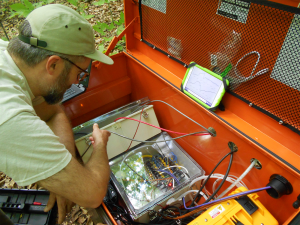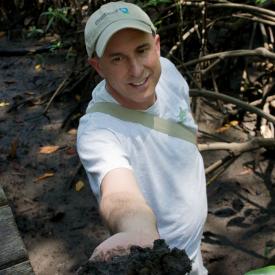Methane Mystery

SERC post-doctoral fellow Dr. Paul Brewer inspects the static-flux equipment used to observe methane emissions from tree trunks.
When scientists and researchers study global climate change, they specifically observe heat-trapping greenhouse gases such as carbon dioxide and methane. While carbon dioxide gas is more widely acknowledged as having an enormous impact on global climate, researchers have observed that methane gas has the ability to trap nearly 45 times as much heat as carbon dioxide. Therefore, to better understand the impact of methane gas in the environment researchers particularly want to track where methane gas comes from (a source), and where methane gas is stored (a sink).

These methane flux chambers made up of large white boxes and colorful tubing measure the amount of methane a tree trunk releases or consumes.
Smithsonian Environmental Research Center (SERC) Intern Andrew Sample, fellow Dr. Paul Brewer, and mentor Dr. Patrick Megonigal in the Biogeochemistry Lab have discovered a way to track the influx and outflux of methane in upland forest tree trunks. In the recently published study in New Phytologist, titled “Temperate forest methane sink diminished by tree emissions” the research team describes how they discovered that trees in upland forests do emit methane. Sample and Megonigal fitted tree trunks with static-flux chambers that could measure methane input and output on a regular basis. From these measurements, the team found that the methane emissions of tree trunks reduce the percentage (by about 1 to 6 percent) by which the forest was acting as a sink. Additionally, in some cases the amount of methane emissions even seemed to switch the forest into a net methane source.
Although this is a large discovery, the researchers at SERC still have many questions. Brewer is continuing this research and exploring the impact of the leaves in the canopy of these upland forest trees have on methane emissions; he is also wondering where such a drastic amount of methane could be coming from. Megonigal speculates that microbial activity within the tree trunks or water underground is a potential source of methane emissions. Brewer has been using the same static-flux chambers developed by Sample and Megonigal to discover the answer to this question. As the research team continues their studies of methane emissions from tree trunks, more and more questions arise.
You can learn more about Dr. Patrick Megonigal’s research with Andrew Sample and Dr. Paul Brewer and the impacts of the team’s findings in a recent SERC blog post here.







